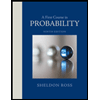A genetic experiment with peas resulted in one sample of offspring that consisted of 443 green peas and 164 yellow peas. a. Construct a 95% confidence interval to estimate of the percentage of yellow peas. b. It was expected that 25% of the offspring peas would be yellow. Given that the percentage of offspring yellow peas from the sample is not 25%, do the results contradict expectations? a. Construct a 95% confidence interval, Express the percentages in decimal form.
A genetic experiment with peas resulted in one sample of offspring that consisted of 443 green peas and 164 yellow peas. a. Construct a 95% confidence interval to estimate of the percentage of yellow peas. b. It was expected that 25% of the offspring peas would be yellow. Given that the percentage of offspring yellow peas from the sample is not 25%, do the results contradict expectations? a. Construct a 95% confidence interval, Express the percentages in decimal form.
A First Course in Probability (10th Edition)
10th Edition
ISBN:9780134753119
Author:Sheldon Ross
Publisher:Sheldon Ross
Chapter1: Combinatorial Analysis
Section: Chapter Questions
Problem 1.1P: a. How many different 7-place license plates are possible if the first 2 places are for letters and...
Related questions
Question

Transcribed Image Text:A genetic experiment with peas resulted in one sample of offspring that consisted of 443 green peas and 164 yellow peas.
a. Construct a 95% confidence interval to estimate of the percentage of yellow peas.
b. It was expected that 25% of the offspring peas would be yellow. Given that the percentage of offspring yellow peas from the sample is not 25%, do the results contradict expectations?
a. Construct a 95% confidence interval. Express the percentages in decimal form.
<p<
(Round to three decimal places as needed.)
b. Given that the percentage of offspring yellow peas from the sample is not 25%, do the results contradict expectations?
O Yes, the confidence interval does not include 0.25, so the true percentage could not equal 25%
O No, the confidence interval includes 0.25, so the true percentage could easily equal 25%
Expert Solution
This question has been solved!
Explore an expertly crafted, step-by-step solution for a thorough understanding of key concepts.
This is a popular solution!
Trending now
This is a popular solution!
Step by step
Solved in 3 steps

Recommended textbooks for you

A First Course in Probability (10th Edition)
Probability
ISBN:
9780134753119
Author:
Sheldon Ross
Publisher:
PEARSON


A First Course in Probability (10th Edition)
Probability
ISBN:
9780134753119
Author:
Sheldon Ross
Publisher:
PEARSON
